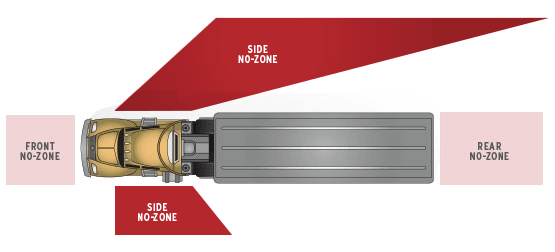From 2011 to 2020, fatal crashes involving large trucks increased by 33%. In 2020, 9% of all fatal vehicle crashes involved large trucks.
Trucks move nearly 75% of the nation’s freight. Without them, the supply chain would grind to a halt. It’s tough work driving a semi–often made tougher by other drivers on the road who don’t give trucks the space they need to maneuver.
In 28 years of legal practice, our Salt Lake car accident lawyers have seen countless scenarios where lives were lost–or compromised forever–due to accidents with semi-trucks. We can’t overemphasize the importance of driving with care around these big rigs. Here are 10 tips for sharing the road and minimizing accident risks.
1. Expect slowdowns. The first tip is simply to adjust your mindset. Many of us get so focused on getting from point A to point B in a hurry that we forget that driving involves many variables. One of those variables is semi-trucks. They’re big and lumbering, and sharing the road with them often means we have to slow down and accommodate them. Get in the practice of leaving your home early! That way, if something slows you down on the road you’re not panicking or driving recklessly in order to make up a few minutes.
2. Stay out of their blind spots. You’ve likely tried to make a turn on the road or change lanes only to see a car come out of nowhere. They were in your blind spot! Just as your car has blind spots, semi-trucks do, too–and theirs are far larger than yours. Check out this visual from the Utah Department of Transportation that illustrates big trucks’ four blind spots:

The blind spot on the left side of the truck can cover at least one lane; the blind spot on the right can cover several. One of the worst things you can do is cruise along in the side shadow of a semi-truck. If you need to pass a semi-truck, do so fast and then get out of their blind spots as soon as possible.
Pro-tip: Watch truck drivers’ mirrors. If you can’t see them in their side mirrors, they probably can’t see you.
3. Let them merge/change lanes. Defer to trucks that are trying to get onto the freeway. This may mean that you have to press on that brake and lose some speed to let them in. The worst thing you can do is speed up, get in their way, and keep them from making a safe entrance onto the freeway.
4. Let them turn. You may be able to maneuver a hairpin turn, but big rigs can’t. Watch for a truck’s signals and stay out of their way when they’re trying to turn. This may mean that you lose some speed as you wait on the truck. The disastrous alternative is to try to race alongside of a truck on the right because you don’t want to wait for them to complete their right hand turn!
5. Don’t cut them off. Big rigs carry tens of thousands of pounds, making it nearly impossible for them to stop quickly. It’s best for semi-truck drivers to keep five to six car lengths of space in front of them. If you zoom into that safe space, you’re at risk of being rear ended.
If you are passing a truck, allow that five to six-car buffer before you move in front of them. This is especially true in bad weather, where you should plan to double that buffer.
If you’re driving in front of a semi, you should also keep a safe space in front of your car so that you don’t have to slam on your brakes and cause the truck driver behind you to do the same.
6. Don’t tailgate. Just as you shouldn’t pass too close in front of a semi, you shouldn’t ride too close to their bumper either. Open up the same buffer of several car lengths.
If you get any closer, they won’t be able to see you. What’s more, you’ll put yourself in danger should the truck blow one of its tires. Because truckers put so much mileage on their tires, they are prone to blowouts, and the force of one of those big tires hitting your windshield can cause just as much damage as if you were hit by an actual truck.
7. Don’t pass on a downward slope. Semi-trucks pick up a lot of momentum on steep downgrades, so stay out of their way. If you want to pass, a downgrade is not the place. Wait until the road levels off.
Injured in a semi-truck accident?
If you do become injured in a crash with a semi-truck, or if you have been injured by a semi-truck accident in the recent past, contact our LifeLaw semi truck accident attorneys. We have training specific to these types of crashes. We’ve dealt with the insurance companies that try to pin fault on everyone but their own clients and try to pass off victims’ injuries as pre-existing conditions.
We can help you know how strong your legal case is–even if you bore some fault in the accident–and help you walk through the intricacies of personal injury law so that you can get the compensation that you deserve.
